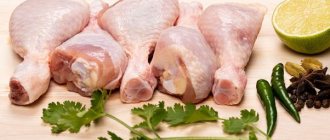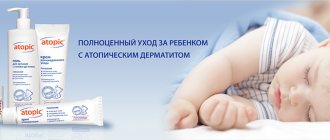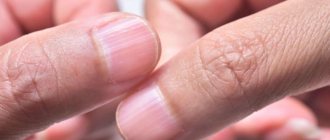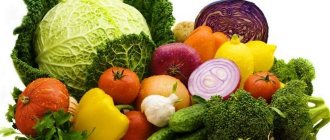General recommendations for creating a menu for atopic dermatitis
An allergy or hypersensitivity reaction is a specific condition of the body that occurs upon contact with certain substances, allergens.
They enter the bloodstream and lead to the appearance of extensive red spots and rashes on the skin, which may be accompanied by itching and fever.
To prevent such a reaction, it is recommended to introduce certain restrictions into the child’s diet.
What are the general recommendations when creating a menu for a baby with this disease:
- It is worth excluding potentially dangerous products that can lead to allergies, such as various canned foods, marinades rich in vinegar and spices, semi-finished products whose composition is unclear, and mushrooms.
- Limit the consumption of fatty and unhealthy foods: pork, chicken, eggs, even sawn eggs will be prohibited.
- Red vegetables and fruits are also dangerous for children with a similar diagnosis; they can lead to skin rashes.
- Dairy products with a high level of fat are not recommended for dermatitis and can cause harm to the body.
- Baked goods, sweets and snacks, they are rich in harmful substances, irritate the mucous membrane of the stomach and intestines and contribute to the accumulation of toxins.
- Carbonated drinks and packaged juices are prohibited for children of all ages, as they overload the gastrointestinal tract and liver.
Three basic rules to follow when following a diet.
Table 1. Diet rules
| First: | It is worth eating fresh and natural foods. Carefully monitor expiration dates. |
| Second: | Eliminate sugar and foods containing it in high concentrations, partially replace them with fructose. |
| Third: | Keep a diary to track your reactions to food. |
It is advisable to consult a doctor when creating a menu; he will help you eliminate foods that can lead to similar problems.
Atopic dermatitis and infant formula nutrition
Of course, most modern mothers, despite any difficulties, will try to feed their baby with their milk. If the mother is healthy and does not take antibiotics or any other chemotherapy drugs, then breastfeeding is the best thing she can give her baby.
There are cases:
- The mother herself suffers from allergies or food intolerance to some foods, which force her to maintain such a strict diet that it becomes a real torment for both her and her child. But the rashes still continue;
- There is simply no milk.
In these cases, it is necessary to transfer the child to artificial feeding. The main thing you must learn and remember from this part of the article is that the so-called hypoallergenic mixtures are LOW allergenic, and not completely non-allergenic. That is, hypoallergenic formulas (HA) are intended for feeding children with a predisposition to allergies, but not for children with obvious diathesis.
Elimination diet for atopic dermatitis
It is difficult for children to tolerate strict dietary restrictions; a growing body needs nutrients and minerals.
It is recommended for such children:
- gradually introduce new products to the menu, monitoring the reaction;
- At first, limit the consumption of meat, fermented milk and other dishes.
They start with porridges, cereals and low-fat meat broths, which are easily absorbed by the body and do not cause digestive problems.
Gradually, new products are added to the diet, carefully monitoring the body's reaction to their use. It is better to fix the menu, write down everything that the baby eats. If an inadequate reaction occurs, the product is removed.
Rotation diet for atopic dermatitis
It has a different principle, it consists in observing the following rules:
- The menu is designed in such a way that a new product appears on it at least once every 4 days.
- A menu is created for the day from one type of meat, cereal, and vegetables.
- If a child develops an allergy, then after 5 days a new product is given in combination with others.
- The reaction is repeated - completely excluded from the diet.
This diet will help identify the allergen; it is suitable for those children who, according to their parents, react “to everything.”
Table of allergenicity of products from the Union of Pediatricians
If we talk about the allergenicity of food products, then it largely depends on the body’s susceptibility to food allergens. But there are general recommendations that the Union of Pediatricians recommends following.
Table 2. Permitted and prohibited products
| What you can't eat: | It is possible, but in moderation: | Allowed: |
| Fatty and spicy dishes, spiced cheeses, pickled delicacies. | Whole milk and butter. | Bread made from rye flour. |
| Confectionery and chocolate, as well as desserts with high cocoa content. | Cornflakes. | Cereals: buckwheat, lentils, rice (you will have to soak it first), oatmeal. |
| Mushrooms in any form. | Semolina, white bread. | Lean meat: preference is given to rabbit, lamb, veal, you can include beef tenderloin in the diet. |
| Baked goods made from refined flour, sugar. | Onions and cucumbers. | Olive oil, white cabbage and broccoli. |
| Exotic fruits, fruits and vegetables of red and orange color. | Cranberries, sea buckthorn and other berries are red or yellow. | Zucchini stewed or baked. |
| Honey, nuts, most dried fruits, citrus fruits. Margarine and its contents, mayonnaise and other fatty sauces. | Sawing eggs. | White or green apples. |
| Smoked, canned and salted fish, meat, store-bought convenience foods, carbonated drinks. | Pasta made from durum wheat. | Cottage cheese, kefir, fermented baked milk with low fat content. |
More often, skin rashes appear after eating honey, nuts, red fruits, and citrus fruits. This reaction is also observed when fish dishes are included in the menu. It is rich in mercury, which accumulates under the fins and gills. Therefore, children with atopic dermatitis who are forced to follow a diet do not have fish or seafood in their diet.
How to maintain a balance of proteins, fats and carbohydrates?
The diet for chronic atopic dermatitis is selected in such a way that the patient’s menu maintains a balance between the consumption of proteins, fats and carbohydrates. When the volume of one of these elements decreases, the body experiences a deficiency, which affects the functioning of all internal organs and systems. Such an “imbalance” can lead to exacerbation of chronic diseases, including the appearance of skin rashes.
To ensure the supply of necessary substances, the menu should include:
- Proteins in an amount of at least 30% of the total volume of incoming food. Protein (or protein) is the main building block for body tissues. For atopic dermatitis, it is especially necessary because it helps restore damaged skin. The main sources of protein are veal, rabbit and turkey meat, fish, and dairy products.
- Carbohydrates in an amount of at least 50% of the volume of daily food consumed. Carbohydrates become the main source of energy; they help keep the body in good shape. Also, many fruits and vegetables rich in carbohydrates contain essential fiber, which ensures the normal functioning of the gastrointestinal tract. You can get a large amount of carbohydrates from vegetables, fruits and cereals.
- Fats in an amount of at least 20% of the total food eaten per day. Thanks to fats, many vital processes in the body are supported; they are important elements in the production of hormones and the construction of cell membranes. Fats keep the skin healthy, it becomes firm and elastic, and its natural protective barrier is maintained. Depending on individual health conditions, doctors often insist on increasing fat intake by reducing the amount of carbohydrates. This is a perfectly acceptable compromise.
If, due to food intolerance, the patient is unable to achieve sufficient protein intake, then in this case it is recommended to include special hypoallergenic protein supplements in the nutrition plan.
Cross-reactivity of some products
What is compatibility and what products are best combined with each other?
Table 3. Product compatibility
| Pasta and potatoes: | Combine with lean meat, boiled or stewed. You can add a little cheese. |
| Dairy products: | We combine kefir or natural yogurt with apples; you can eat it with rye flour bread. |
| Vegetable stew: | They go well with boiled meat; you can bake foods together. |
| Cereals: | We successfully combine them with milk and add a little butter. |
You should not combine cereals with meat, cheese, and pasta with butter; it is better to use olive oil.
The most allergenic and safest products for children with atopic dermatitis
When compiling a diet, the degree of safety and danger of products is taken into account; the indicators are shown in Table 4.
Table 4
| Dangerous: | Safe products: |
| Honey, chocolate, nuts, seafood, oranges, tangerines, kiwi, pineapple, watermelon, melon, eggs. Red berries. Various spices and herbs, caviar. | Kefir, low fat, rabbit, turkey or veal. Cabbage, buckwheat, rye flour bread. Cottage cheese, green apples. |
Dangerous foods are excluded from the diet in any case, since when they are consumed, there is a high probability of developing a hypersensitivity reaction. But when consuming safe ones, such problems do not arise.
Highly allergenic foods
The products that most often cause allergies include:
- Chicken eggs, chicken meat, cow's milk, mushrooms, citrus fruits (oranges, tangerines, grapefruits), pineapples, persimmons, melons, strawberries, raspberries, wild strawberries, black catfish, honey, chocolate and candies, nuts (especially peanuts), fish, seafood products , fish caviar, smoked products, sausages, canned products, dried fruits, sweet carbonated drinks, coffee, cocoa, products with a large number of chemical additives (preservatives, dyes, flavors, stabilizers), wheat, rye
When creating a hypoallergenic and elimination diet for atopic dermatitis in adults and children, they should be avoided without fail, especially in the case of nursing mothers.
Diet for adults and teenagers
There are no serious differences and consists in following basic rules. Food allergies occur more often in children than in adolescents and adults.
What should be excluded from the diet:
- coffee and drinks containing high concentrations of caffeine;
- strong tea with herbs and berries - can lead to a rash on the body;
- various types of alcohol, since its consumption leads to the accumulation of toxins and harmful substances;
- bakery and pasta products made from refined flour;
- various sushi, snacks rich in herbs and spices are also prohibited.
Over the years, with the correct menu design, it will be possible to remove from the diet those foods that are most dangerous for humans. So, teenagers and adults are not prohibited from eating carrots, bananas, soybeans, and potatoes. They are conditionally safe for the body. But they are prohibited for children.
Disputes also arise regarding cheeses; preference is given to those that are not high in fat, but it is better not to give them to children.
treatment goals
- stopping the appearance of new rashes;
- epithelization of erosions;
- achieving and maintaining remission;
- improving the quality of life of patients.
general notes on therapy
- The basis of therapy is a gluten-free diet, which leads to resolution of the skin process, elimination of enteropathy, disappearance of IgA antibodies to gliadin, endomysium and tissue transglutaminase.
- The drug of choice for treating patients is dapsone. Dapsone therapy requires careful laboratory monitoring, especially liver and kidney function. Serious side effects may develop, especially hemolysis. Severe hypersensitivity syndrome may also develop.
- If adverse events occur during dapsone therapy or its ineffectiveness, sulfasalazine may be prescribed. During therapy with sulfasalazine, hypersensitivity reactions, hemolytic anemia, proteinuria and crystalluria may occur. To monitor adverse effects of drug therapy, a clinical blood test and a general urine test are prescribed, which are carried out before starting therapy and monthly for the first 3 months, then once every 6 months. The most common adverse events of sulfasalazine therapy—nausea, vomiting, and lack of appetite—are prevented by prescribing enteric forms of the drug.
- Systemic glucocorticosteroid drugs are ineffective.
diet
Wheat, barley, rye, oats and other grains should be completely eliminated from the diet. It is also necessary to exclude foods containing iodine (seafood, feijoa, persimmon, etc.). A gluten-free diet leads to regression of rashes after 1-2 years, however, dermatitis herpetiformis invariably recurs within 12 weeks after re-ingestion of gluten from food, and therefore patients must adhere to the diet for life. Only 10-20% of patients develop immune tolerance and are able to maintain a normal diet after several years of a strict gluten-free diet; this is most often observed in cases of childhood onset and in patients treated with dapsone. Strict adherence to a gluten-free diet for a long time leads to to reduce the need for medications, reduce the risk of developing intestinal lymphomas, resolve skin rashes and symptoms of enteropathy/malabsorption.
Systemic therapy
- dapsone 1 mg per kg body weight orally per day for 1-2 years (until the onset of a lasting effect of the gluten-free diet)
- sulfasalazine orally at a dose of 1-2 g per day.
Note. In the instructions for medical use of sulfasalazine, dermatitis herpetiformis is not included in the indications for use of the drug.
Antihistamines may be used to control itching, alternating every 10 days as needed:
- clemastine 1 mg orally 2 times a day for 7-10 days
- chloropyramine 25 mg orally 1-2 times a day for 7-10 days
- Loratadine 10 mg once daily orally for 7-10 days
- mebhydrolin 50-200 mg orally 1-2 times a day for 7-10 days.
For severe itching, parenteral administration of antihistamines is indicated:
- clemastine 2 mg intramuscularly at night for 7 days, or
- chloropyramine 20-40 mg intramuscularly at night for 7 days.
External therapy
Topical glucocorticosteroid drugs can be used for severe itching to reduce it:
- clobetasol propionate 0.05% ointment, cream on the affected areas 1 time per day, or
- triamcinolone 0.1% ointment on the lesions 2 times a day, or
- betamethasone 0.01% ointment on the lesions 2 times a day.
Treatment of blisters and erosions. The area of blisters and erosions is treated with a solution of aniline dyes, and in the presence of a secondary infection - with aerosols containing glucocorticosteroids and antibacterial drugs. Antiseptic rinse solutions are applied to erosions in the area of the oral mucosa.
Treatment of children.
The recommended dosage of dapsone in children is 2 mg per kg of body weight per day.
indications for hospitalization
- lack of effect from treatment carried out on an outpatient basis;
- the appearance of new rashes;
- the presence of secondary infection in the lesions.
requirements for treatment results
- regression of rashes;
- epithelization of erosions;
- disappearance of itching.
tactics in the absence of effect from treatment
If there is no effect from therapy with dapsone at a dosage of 1 mg per kg of body weight per day, the dosage of the drug can be increased to 150-200 mg per day for a short course or oral sulfasalazine therapy can be prescribed.
prevention
Primary prevention of dermatitis herpetiformis has not been developed. A secondary prevention measure is adherence to a gluten-free diet in patients with dermatitis herpetiformis and gluten enteropathy (celiac disease).
Diet for pregnant and lactating women
If, during the period of bearing a child, a woman does not monitor her diet, then the risk of the baby developing dermatitis increases. On average it increases by 15-20%.
What foods are prohibited for pregnant and nursing mothers:
- Fatty and fried foods, chocolate and drinks containing caffeine.
- Exotic fruits because they may contain harmful preservatives.
- Carbonated drinks, smoked foods, salty canned food and processed foods will cause swelling and increase blood pressure levels.
- Sweets in large quantities, fatty sauces and pickled dishes, garlic, onions.
- Red and orange fruits and vegetables are often the cause of food allergies.
The diet should be balanced; a woman is recommended to eat food in small portions; if she is very hungry, then have snacks. Drink kefir and eat apples.
Causes of seborrhea
Treatment for seborrheic dermatitis depends on its causes, research into which is still ongoing. A connection between the pathology and a genetic (hereditary) factor was revealed. It has also been noted that seborrheic dermatitis often develops in patients with Parkinson's disease.
Many parents are interested in how to treat seborrhea in infants up to one year old. The cause of pathology at birth is the high activity of the glands under the influence of maternal androgens. If endogenous androgen continues to be actively produced throughout life, seborrhea may recur.
The following factors increase the risk of developing the disease:
- viral or bacterial infection;
- fungus malassezia furfur;
- stress, mental stress, prolonged depression and neuroses;
- regular lifting of weights, intense physical activity;
- genetic chemical composition of skin secretions;
- hormonal changes in the body;
- poor diet, frequent diets;
- bad habits (alcoholism, smoking).
Features of cooking porridge
We will cook with milk, with the addition of butter, provided that its fat content does not reach 82.5%. What to do:
- Add milk to the water and add cereal; first soak it and rinse it under running water.
- We wait until the porridge boils and reduce the temperature, bring the dish to readiness, stirring occasionally.
- At the final stage, add salt (just a little), and before serving, add butter.
We must heat-treat the milk and do not add it to ready-made porridge cooked in water. This will increase the risk of developing a lactose allergy.
Soups
We will cook with meat broth, choosing a suitable piece of tenderloin, what to do:
- Boil the meat, drain the water twice during cooking, after boiling;
- then place the vegetables for the soup into the boiling broth, after chopping them;
- remove the meat and let it drain; when the vegetables are almost ready, add it to the soup;
- Add salt a few minutes before the dish is ready, mix everything thoroughly with a wooden spoon.
Using this scheme, you can prepare any soup, taking into account the child’s preferences. We select the ingredients correctly, avoiding red vegetables, which lead to the development of an allergic reaction.
You should not prepare milk soup for a baby with allergic dermatitis; pasta in combination with milk can lead to a rash.











